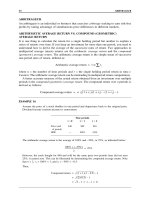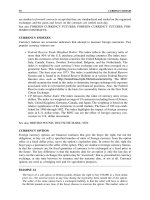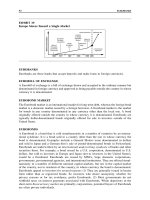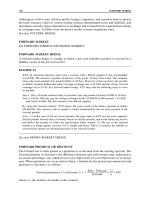International aeronautical and maritime search and rescue manual, volume iii
Bạn đang xem bản rút gọn của tài liệu. Xem và tải ngay bản đầy đủ của tài liệu tại đây (1.1 MB, 172 trang )
IAMSAR Manual
INTERNATIONAL AERONAUTICAL AND
MARITIME SEARCH AND RESCUE MANUAL
Volume III
MOBILE FACILITIES
Published in 1998 by the
INTERNATIONAL MARITIME ORGANIZATION
4 Albert Embankment, London SE1 7SR, United Kingdom
and the
INTERNATIONAL CIVIL AVIATION ORGANIZATION
999 University Street, Montreal, Quebec, Canada H3C SH7
Printed in the United Kingdom by Ashford Press
2
4
6
8
10
9
7
5
3
1
ISBN 92-801-6085-0
IMO PUBLICATION
IMO sales number: IMO-962E
Copyright
©
IMO/ICAO
1998
All rights reserved.
No part of this publication may, for sales purposes,
be produced, stored in a retrieval system or transmitted
in any form or by any means, electronic, electrostatic,
magnetic tape, mechanical, photocopying or otherwise,
without prior permission in writing from the
International Maritime Organization or
the International Civil Aviation Organization.
Foreword
purpose of the three volumes of the International
Aeronautical and Maritime Search and Rescue Manual is to assist States
The primary
in meeting their own search and rescue (SAR) needs, and the
obligations they accepted under the Convention on International Civil
Aviation, the International Convention on Maritime Search and Rescue,
and the International Convention for the Safety of life at Sea (SOlAS).
These volumes provide guidelines for a common aviation and maritime
approach to organizing and providing SAR services. States are
encouraged to develop and improve their SAR services, co-operate
with neighbouring States, and to consider their SAR services to be part
of a global SAR system.
Each IAMSAR Manual volume is written with specific SAR system duties
in mind, and can be used as a stand-alone document, or, in conjunction
with the other two volumes, as a means to attain a full view of the SAR
system.
• The Organization and Management volume (volume I) discusses the
global SAR system concept, establishment and improvement of
national and regional SAR systems, and co-operation with neighbouring States to provide effective and economical SAR services;
• The Mission Co-ordination volume (volume II) assists personnel who
plan and co-ordinate SAR operations and exercises; and
• The Mobile Facilities volume (volume III) is intended to be carried
aboard rescue units, aircraft, and vessels to help with performance of
a search, rescue, or on-scene co-ordinator function, and with aspects
of SAR that pertain to their own emergencies.
This Manual is published jointly by the International Civil Aviation
Organization and the International Maritime Organization.
Contents
Abbreviations and Acronyms ..........................................................
vii
Glossary ...........................................................................................
xi
Section 1: Overview ........................................................................
1-i
Section 2: Rendering Assistance .....................................................
2-i
Section 3: On-Scene Co-ordination ................................................
3-i
Section 4: On-Board Emergencies...................................................
4-i
Appendices
Appendix A:
Regulation V/10 of the International
Convention for the Safety of Life
at Sea, 1974 ........................................................
A-1
Appendix B:
Search Action Message .......................................
B-1
Appendix C:
Factors Affecting Observer Effectiveness ............. C-1
Appendix D:
Standard Format for Search and Rescue
Situation Report (SITREP)....................................
D-1
SAR Briefing and Debriefing Form ......................
E-1
Appendix E:
v
Abbreviations and Acronyms
....................................................................................
A
search area
AjC ...........................................................................................
aircraft
ACO ......................................................................
aircraft co-ordinator
AM ...................................................................
AMVER ...........................
Automated
amplitude modulation
Mutual-assistance Vessel Rescue
ATC ............................................................................
air traffic control
ATS ...........................................................................
air traffic services
CES .........................................................................
coast earth station
CIRM ...........................................
Centro Internazionale
CRS .........................................................................
Radio-Medico
coast radio station
CIS .........................................................................................
call sign
creeping line search
CS ......................................................................
CSC .................................................
creeping line search, co-ordinated
CSP ................................................................
commence search point
C;W ...........................................................................
continuous wave
OF ............................................................................
OMB .....................................................................
direction finding
DR
.............................................................................
datum marker buoy
dead reckoning
OSC ...................................................................
digital selective calling
ELT .......................................................
emergency locator transm itter
EPIRB ...............................
emergency position-indicating
ETA ................................................................
ETO ..........................................................
estimated time of arrival
estimated time of departure
FfV .................................................................................
FM ...................................................................
fw
..............................................................
GES ......................................................................
radio beacon
fishing vessel
frequency modulation
weather correction factor
ground earth station
VII
Abbreviations
and Acronyms
GHz .......................................................................................
GMDSS ...............................
global maritime distress and safety system
GPS ..............................................................
global positioning system
GS
................................................................................
gt
.......................................................................................
HF
..............................................................................
ICAO .....................................
grou nd speed
gross ton
high frequency
International Civil Aviation Organization
IFR ....................................................................
IMC ............................................
IMO .............................................
Inmarsat ............................
gigahertz
instrument flight rules
instrument meteorological
conditions
International Maritime Organization
International Mobile Satellite Organization
INTERCO ................................................
International Code of Signals
JRCC ........ joint (aeronautical and maritime) rescue co-ordination centre
kHz ........................................................................................
kt
.........................................................
kilohertz
knot (nautical mile per hour)
LCB .................................................................
Iine of constant bearing
LES ..........................................................................
land earth station
LKP .......................................................................
last known position
LUT .........................................................................
local user terminal
LW
...........................................................................................
leeway
m
............................................................................................
metre
M/V ............................................................................
MCC ..................................................................
mission control centre
MEDEV AC .............................................................
MEDiCO ............................................
MF
merchant vessel
medical evacuation
medical advice, usually by radio
........................................................................
medium frequency
MHz .....................................................................................
megahertz
MSI ...........................................................
maritime safety information
NBDP .........................................................
narrow-band direct printing
viii
Abbreviations and Acronyms
NM ..................................................................................
OSC ....................................................................
nautical mile
on-scene co-ordinator
PIW .............................................................................
person in water
PLB ................................................................
personal locator beacon
POB ..........................................................................
PS
persons on board
....................................................................
parallel sweep search
..,..............................................................................
R
RfT .............................................................................
search radius
radio telephony
RANP .........................................................
regional air navigation plan
RCC ...........................................................
rescue co-ordination
RSC ....................................................................
,..... rescue sub-centre
RTG ............................................................................
radio telegraphy
RlT ................................................................................
radio teletype
.................................................................................
S
SjV ..................................................................................
SAR .........................................................................
SART ....................................................
centre
track spacing
sailing vessel
search and rescue
search and rescue transponder
search and rescue co-ordi nator
SC .....................................................
SES ...........................................................................
ship earth station
SITREP ..........................................................................
SMC. .......................................
situation report
search and rescue mission co-ordinator
SOLAS ..................................................................
Safety of Life at Sea
SRR ..............................................................
SRS ........................................................
search and rescue region
search and rescue sub-region
SRU ..................................................................
SS ...............................................................
SSB ..............................................................................
search and rescue unit
expanding square search
single-sideband
SU
....................................................................................
T
.....................................................................
search unit
sea'rch time available
IX
Abbreviations
and Acronyms
............... ,....................................................................
T
true course
TAS ... ,............................................................................
true air speed
track line search
TS ... ,........................................................................
TSN ..........................................................
track line search, non-return
UHF ......................................................................
UTC ...........................................................
V
ultra high frequency
co-ordinated
.............................................................
SAR facility grou nd speed
VFR ............................................................................
VHF ......................................................................
VMC ..................................................
VS
universal time
visual flight rules
very high frequency
visual meteorological
.................................................................................
conditions
sector search
wr ..............................................................................
radio telegraph
x
Glossary
A person who co-ordinates the involvement
Aircraft co-ordinator
of multiple aircraft in SAR operations.
(ACO)
A world-wide vessel reporting system for
Automated Mutualassistance Vessel Rescue SAR for maintaining estimated position and
other data of merchant vessels that
System (AMVER)
voluntarily
participate.
Captain
Master of a ship or pilot-in-command of an
aircraft, commanding officer of a warship, or
an operator of any other vessel.
Coast earth station
(CES)
Maritime name for an Inmarsat shore-based
station linking ship earth stations with
terrestrial communications networks.
Commence search point
(CSP)
Point, normally specified by the SMC, where
a SAR facility is to begin its search pattern.
Conclusion stage
A period during a SAR incident when SAR
facilities return to their regular location and
prepare for another mission.
Cospas-Sarsat System
A satellite system designed to detect distress
beacons transmitting on the frequencies
121.5 MHz and 406 MHz.
Course
The intended horizontal direction of travel
of a craft.
Craft
Any air or sea-surface vehicle, or
submersible of any kind or size.
Datum
A geographic point, line, or area used as a
reference in search planning.
Digital selective calling
(DSC)
A technique using digital codes which
enables a radio station to establish contact
with, and transfer information to, another
station or group of stations.
Direction of waves,
swells, or seas
Direction from which the waves, swells, or
seas are moving.
Direction of wind
Direction from which the wind is blowing.
xi
Glossary
Distress alert
Notification by any means that a distress
situation exists and assistance is needed.
Ditching
The forced landing of an aircraft on water.
Drift
Movement of a search object caused by
environmental forces.
Emergency locator
transmitter (ELT)
Aeronautical radio distress beacon for
alerting and transmitting homing signals.
Emergency positionindicating radio beacon
(EPIRB)
A device, usually carried aboard maritime
craft, that transmits a signal that alerts
search and rescue authorities and enables
rescue units to locate the scene of the
distress.
False alarm
Distress alert initiated for other than an
appropriate test, by communications
equipment intended for alerting, when no
distress situation actually exists.
False alert
Distress alert received from any source,
including communications equipment
intended for alerting, when no distress
situation actually exists, and a notification of
distress should not have resulted.
Fetch
The distance the waves have been driven by
a wind blowing in a constant direction,
without obstruction.
Global maritime distress A global communications service based
upon automated systems, both satelliteand safety system
based and terrestrial, to provide distress
(GMDSS)
alerting and promulgation of maritime safety
information for mariners.
Heading
The horizontal direction in which a craft is
pointed.
Hypothermia
Abnormal lowering of internal body
temperature (heat loss) from exposure to
cold air, wind, or water.
xii
Glossary
Inmarsat
An organization which operates a system of
geostationary satellites for world-wide
mobile communications services, and which
supports the GMDSS and other emergency
communications systems.
leeway
The movement of a search object through
water caused by winds blowing against
exposed surfaces.
MAYDAY
Spoken international distress signal,
repeated three times.
MEDEV AC
Evacuation of a person for medical reasons.
MEDICO
Medical advice. Exchange of medical
information and recommended treatment
for sick or injured persons where treatment
cannot be administered directly by
prescribing medical personnel.
Narrow-band direct
printing (NBDP)
Automated telegraphy, as used by the
NA VTEX system and telex-over-radio.
NA VAREA
One of 16 areas into which the world's
oceans are divided by the International
Maritime Organization for dissemination of
navigation and meteorological warnings.
NA VTEX
Telegraphy system for transmission of
maritime safety information, navigation and
meteorological warnings, and urgent
information to ships.
On-scene
The search area or the actual distress site.
On-scene co-ordinator
(OSC)
A person designated to co-ordinate search
and rescue operations within a specified
area.
PAN-PAN
The international radiotelephony urgency
signal. When repeated three times, indicates
uncertainty or alert, followed by nature of
urgency.
XIII
Glossary
Primary swell
The swell system having the greatest height
from trough to crest.
Rescue
An operation to retrieve persons in distress,
provide for their initial medical or other
needs, and deliver them to a place of safety.
Rescue action plan
A plan for rescue operations normally
prepared by the SMC for implementation
the OSC and facilities on-scene.
by
Rescue co-ordination
centre (RCC)
A unit responsible for promoting efficient
organization of search and rescue services
and for co-ordinating the conduct of search
and rescue operations within a search and
rescue region.
Rescue sub-centre (RSC)
A unit subordinate to a rescue co-ordination
centre established to complement the latter
according to particular provisions of the
responsible authorities.
SafetyN ET
Communications service provided via
Inmarsat for promulgation of maritime
safety information, including shore-to-ship
relays of distress alerts and communications
for search and rescue
co-ordination.
Sea
Condition of the surface resulting from
waves and swells.
Search
An operation, normally co-ordinated by a
rescue co-ordination centre or rescue subcentre, using available personnel and
facilities to locate persons in distress.
Search action plan
Message, normally developed by the SMC,
for passing instructions to SAR facilities and
agencies participating in a SAR mission.
Search and rescue
mission co-ordinator
(SMC)
The official temporarily assigned to coordinate response to an actual or apparent
distress situation.
xiv
Glossary
Search and rescue
region (SRR)
An area of defined dimensions, associated
with a rescue co-ordination centre, within
which search and rescue services are
provided.
Search and rescue unit
(SRU)
A unit composed of trained personnel and
provided with equipment suitable for the
expeditious conduct of search and rescue
operations.
Search and rescue
transponder (SART)
A survival craft transponder that, when
activated, sends out a signal automatically
when a pulse from a nearby radar reaches it.
The signal appears on the interrogating
radar screen and gives the bearing and
distance of the transponder from the
interrogating radar for search and rescue
purposes.
Swell
Swell direction
Swell face
Condition of the surface caused by a distant
wind system. The individual swell appears to
be regular and smooth with considerable
distance between rounded crests.
The direction from which a swell is moving.
The direction toward which a swell is
moving is called the direction swell.
The side of the swell toward the observer.
The back side is the side away from the
observer. These definitions apply regardless
of the direction of swell movement.
Swell velocity
Velocity with which the swells advance with
relation to a fixed point, measured in knots.
Track spacing (5)
The distance between adjacent parallel
search tracks.
True air speed (TAS)
The speed an aircraft is travelling through
the air mass. TAS corrected for wind equals
ground speed.
xv
Glossary
Wave (or chop)
The condition of the surface caused by local
wind and characterized by irregularity, short
distance between crests, whitecaps, and
breaking motion.
Wind current
The water current generated by wind acting
upon the surface of water over a period of
time.
XVI
Section 1 - Overview
Contents
Purpose ......................................................................................
Responsibilities
National
and Obligations
to Assist.. ...............................
and Regional SAR System Organization
....................
SAR Co-ordination
SAR Co-ordinators ..................................................................
SAR Mission Co-ordinator
On-Scene Co-ordinator
.....................................................
..........................................................
Ship Reporting Systems
The Automated Mutual-Assistance Vessel
Rescue (AMVER) System .......................................................
Aircraft
Reporting System ..........................................................
1-1
1-1
1-1
1-2
1-2
1-3
1-4
1-5
l-i
Section 1 - Overview
Purpose
The purpose of the International Aeronautical and Maritime Search and
Rescue Manual for Mobile Facilities, which is intended for carriage
aboard search and rescue units, and aboard civil aircraft and vessels, is
to provide guidance to those who:
• operate aircraft, vessels or other craft, and who may be called
upon to use the facility to support SAR operations
•
may need to perform on-scene co-ordinator functions for multiple
facilities in the vicinity of a distress situation
•
experience actual or potential emergencies, and may require
search and rescue (SAR) assistance.
Responsibilities and Obligations
to Assist
Under long-standing traditions of the sea and various provisions of
international law, ship masters are obligated to assist others in distress at
sea whenever they can safely do so.
The responsibilities to render assistance to a distressed vessel or aircraft
are based on humanitarian considerations and established international
practice. Specific obligations can be found in several conventions,
including the following:
• Annex 12 to the Convention on International Civil Aviation
•
International Convention on Maritime Search and Rescue
•
Regulation V/l0 of the International Convention for the Safety
of Life at Sea, 1974 (SOLAS 1974). (See appendix A).
National and Regional SAR System Organization
Many States have accepted the obligation to provide aeronautical and
maritime SAR co-ordination and services on a 24-hour basis for their
territories, territorial seas, and where appropriate, the high seas.
• To carry out these responsibilities, States have established national
SAR organizations, or joined one or more other States to form a
regional SAR organization
associated with an ocean area or
continent.
1-1
Section 1 - Overview
• A search and rescue region (SRR) is an area of defined dimensions
associated with a rescue co-ordination centre (RCC) within which
SAR services are provided.
o SRRs help
ordinating
world, but
persons in
to define who has primary responsibility for coresponses to distress situations in every area of the
they are not intended to restrict anyone from assisting
distress
o the International Civil Aviation Organization (ICAO) regional air
navigation plans (RANPs) depict aeronautical SRRs
o the International Maritime Organization
depicts maritime SRRs.
(IMO) Global SAR Plan
SAR Co-ordination
The SAR system has three general levels of co-ordination:
•
SAR co-ordinators (SCs)
• SAR mission co-ordinators (SMCs)
•
On-scene co-ordinators (OSCs) .
• SAR Co-ordinators
• SCs are the top level SAR managers; each State normally will have
one or more persons or agencies for whom this designation may be
appropriate.
• SCs have the overall responsibility for:
o establishing, staffing, equipping and managing the SAR system
o establishing RCCs and rescue sub-centres (RSCs)
o providing or arranging for SAR facilities
o co-ordinating SAR training
o developing SAR policies .
• SAR Mission Co-ordinator
•
Each SAR operation is carried out under the guidance of an SMC.
This function exists only for the duration of a specific SAR incident
and is normally performed by the RCC chief or a designee. The SMC
may have assisting staff.
• The SMC guides a SAR operation until a rescue has been effected or
it becomes apparent that further efforts would be of no avail.
1-2
Section 1 - Overview
• The SMC should be well trained in all SAR processes, be thoroughly
familiar with the applicable SAR plans, and:
o gather information about distress situations
o develop accurate and workable SAR action plans
o dispatch and co-ordinate the resources to carry out SAR missions .
•
SMC duties include:
o obtain and evaluate all data on the emergency
o ascertain the type of emergency equipment carried by the missing
or distressed craft
o remain informed of prevailing environmental conditions
o if necessary, ascertain movements and locations of vessels and
alert shipping in likely search areas for rescue, lookout and/or
radio watch
o plot the areas to search and decide on methods and facilities to be
used
o develop the search action plan and rescue action plan as
appropriate
o co-ordinate the operation with adjacent RCCs when appropriate
o arrange briefing and debriefing of SAR personnel
o evaluate all reports and modify search action plan as necessary
o arrange for refuelling of aircraft and, for prolonged search, make
arrangements for the accommodation of SAR personnel
o
arrange for delivery of supplies to sustain survivors
o maintain in chronological order an accurate and up-to-date record
o issue progress reports
o recommend to the RCC chief the abandoning or suspending of
the search
o release SAR facilities when assistance is no longer required
o notify accident investigation authorities
o if applicable, notify the State of registry of the aircraft
o prepare a final report.
• On-Scene
C()-(Jrdinator
• When two or more SAR facilities are working together on the same
mission, one person on-scene may be needed to co-ordinate the
activities of all participating facilities.
1-3
Section 7 - Overview
o The SMC designates an
asc, who
may be the person in charge of
a:
- search and rescue unit (SRU), ship, or aircraft participating in a
search, or
- nearby facility in a position to handle OSC duties.
o The person in charge of the first facility to arrive at the scene will
normally assume the
function until the SMC arranges for that
person to be relieved.
asc
Ship Reporting Systems
•
Ship reporting systems have been established by some States.
•
Merchant vessels may be the only craft near the scene of a distressed
aircraft or vessel.
• A ship reporting system enables the SMC to quickly:
o identify vessels in the vicinity of a distress situation, along with
their positions, courses, and speeds
o be aware of other information about the vessels which may be
valuable (whether a doctor is aboard, etc.)
o know how to contact the vessels.
•
Masters of vessels are urged to send regular reports to the authority
operating a ship reporting system for SAR.
• The Automated Mutual-Assistance Vessel Rescue
(AMVER) System
• AMVER is a world-wide system operated exclusively to support SAR
and make information available to all RCCs.
o there is no charge for vessels to participate in, nor for RCCs to use,
AMVER
o many land-based providers of communications services worldwide relay ship reports to AMVER free of charge.
• Any merchant vessel of 1000 gross tons or more on any voyage of
greater than 24 hours is welcome to participate.
•
Benefits of participation include:
o improved likelihood of rapid aid during emergencies
o reduced number of calls for assistance to vessels unfavourably
located to respond
o reduced response time to provide assistance.
1-4
Section 1 - Overview
Information voluntarily provided by vessels to AMVER is protected by
the US Coast Guard as commercial proprietary data and made
available only to SAR authorities or others specifically authorized by
the ship involved .
•
For further information
regarding AMVER contact:
AMVER Maritime Relations
Commandant (G-OPR)
2100 2nd Street SW
Washington, DC 20593
USA
Telephone: +1 202 688 7764
Facsimile: + 1 202 668 7684
Aircraft Reporting System
• Aircraft typically rely upon air traffic services (ATS) units for flight
following and communications services .
•
Pilots are encouraged to file flight plans with the appropriate ATS unit
to ensure expeditious response to an emergency.
1-5
Section 2 - Rendering Assistance
Contents
Initial Action by Assisting Craft
Vessels Assisting
Methods of Distress Notification ................................ ···..··
Immediate Action .................................... ·..························
Proceeding to the Area of Distress ...................................
On-Board Preparation
Life-saving and rescue equipment .................................
Signalling equipment ...................................... ··········..····
Preparations for medical assistance........................... ··..
Miscellaneous equipment ..............................................
Vessels Not Assisting .............................................................
Aircraft Assisting
Distress Call and Message Received................................ ·
Immediate Action ................................... ····························
Proceeding to Area of Distress
Navigation equipment. ........................................ ···········
Commu nications equ ipment. ..................................... ····
Miscellaneous equipment ..............................................
Search Function
Search Action Plan and Message..................................... ·
Developing Own Search Planning ....................................
Search Patterns............................ ·······································
On-Scene Radiocommunications ......................................
Visual Communications .....................................................
Look-outs ............................................................................
2-1
2-1
2-4
2-4
2-5
2-5
2-5
2-6
2-6
2-6
2-7
2-7
2-7
2-8
2-9
2-9
2-10
2-10
2-14
2-14
2-15
Day ................................. ·············..································ .
Night ......................................... ···..································ .
Rescue Function
Rescue Action Plan and Message .................................... ·.... 2-15
Developing a Rescue Plan................................................. 2-16
2-i
Section 2 - Rendering Assistance
Assistance by SAR Aircraft
Supply Dropping ................................................................
2-17
Assistance by Helicopters ..................................................
2-18
Rescue Sling ...................................................................
2-19
Double Lift Method .......................................................
2-19
Rescue Basket ................................................................
2-20
Rescue Net .....................................................................
2-20
Rescue Litter ...................................................................
2-20
Rescue Seat....................................................................
2-21
Helicopter Operations
General ...............................................................................
2-21
Communications between Ship and Helicopter
for Winching Operations ...................................................
2-22
Helicopter to Ship ..........................................................
2-22
Ship to Helicopter ..........................................................
2-23
Sample Briefing to Vessel Prior to
Helicopter Winching ..........................................................
2-24
Vessel Preparation ..............................................................
2-25
Positioning of Landing or Pick-up Areas........................ 2-25
Safety Preparations.............................................................
2-27
Rescue by Maritime Facilities
General Maritime Considerations ...................................... 2-30
Ocean incident. ..............................................................
2-32
Coastal incident. .............................................................
2-32
Assistance to Ditching Aircraft ..........................................
2-32
Rescue by Aircraft
Sighting and Subsequent Procedures ................................ 2-33
2-ii
Fixed-Wing Aircraft... ..........................................................
2-34
Helicopters .........................................................................
2-35
Seaplanes and Amphibians ................................................
2-35
Rescue by Land Facilities.......................................................
2-35
Section 2 - Rendering Assistance
Care of Survivors
Immediate
Care of Survivors .............................................
2-35
Debriefing
of Survivors ......................................................
2-37
Handling
of Deceased
Persons .............................................
Contact with the Media .........................................................
Other Assistance ........................................................................
Intercept
Intercepts ...................................................................
Direct Intercepts .................................................................
The head-on direct intercept
The overtaking
2-40
Minimum
2-40
2-41
2-41
.........................................
2-42
direct intercept... ...................................
2-43
2-44
The offset or beam-on
Aircraft
2-39
and Escort Service
General ...............................................................................
Aircraft
2-38
intercept.. ..................................
Time to Scene Intercept
(MTTSI) ......................
2-48
Ditching
Aircraft Ditching
Guidance ................................................
2-50
Surface Craft Assistance .....................................................
2-50
Communications
Radio ...............................................................................
2-50
Vi sual ..............................................................................
2-51
Assistance from Ships ........................................................
2-51
Rescue and Care of Survivors .......................................
2-53
Training
Search and Rescue Personnel ...............................................
2-53
Air Search and Rescue Facilities ............................................
2-53
Pilots ...................................................................................
2-54
Navigators ..........................................................................
2-54
Observers ...........................................................................
2-54
Supply Droppers ................................................................
2-55
Maritime
Search and Rescue Facilities
Crew Members ..................................................................
2-55
Deck Officers .....................................................................
2-56
Radio Operators .................................................................
2-57
2-iii
Section 2 - Rendering Assistance
look-outs ............................................................................
Crews of Rescue Boats ......................................................
First Aid ..............................................................................
land Search and Rescue Facilities ........................................
Pararescue and Paramedical Personnel ................................
Depot Personnel ....................................................................
Masters and Officers of Merchant Ships ..............................
2-iv
2-57
2-57
2-57
2-58
2-59
2-60
2-60
Section 2 - Rendering Assistance
Initial Action by Assisting Craft
Vessels Assisting
• Methods of Distress Notification
• An alarm signal or a distress call from another vessel at sea, either
directly or by relay.
• A distress call or message from aircraft. This usually occurs by relay
from a CRS.
• Alert sent from a vessel's alerting equipment and then relayed shoreto-ship.
• Visual signals or sound signals from a nearby distressed craft.
• Immediate Action
• The following immediate action
receiving a distress message:
D acknowledge
should
be taken
by any ship
receipt of message.
D gather the following
information
from the craft in distress if
possible:
-
position of distressed craft
- distressed craft's identity, call sign, and name
-
number of POBs
-
nature of the distress or casualty
- type of assistance required
-
number of victims, if any
- distressed craft's course and speed
- type of craft, and cargo carried
- any other pertinent information
that might facilitate the rescue
2-1









